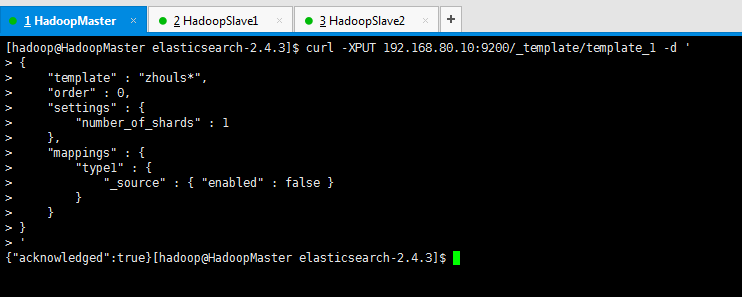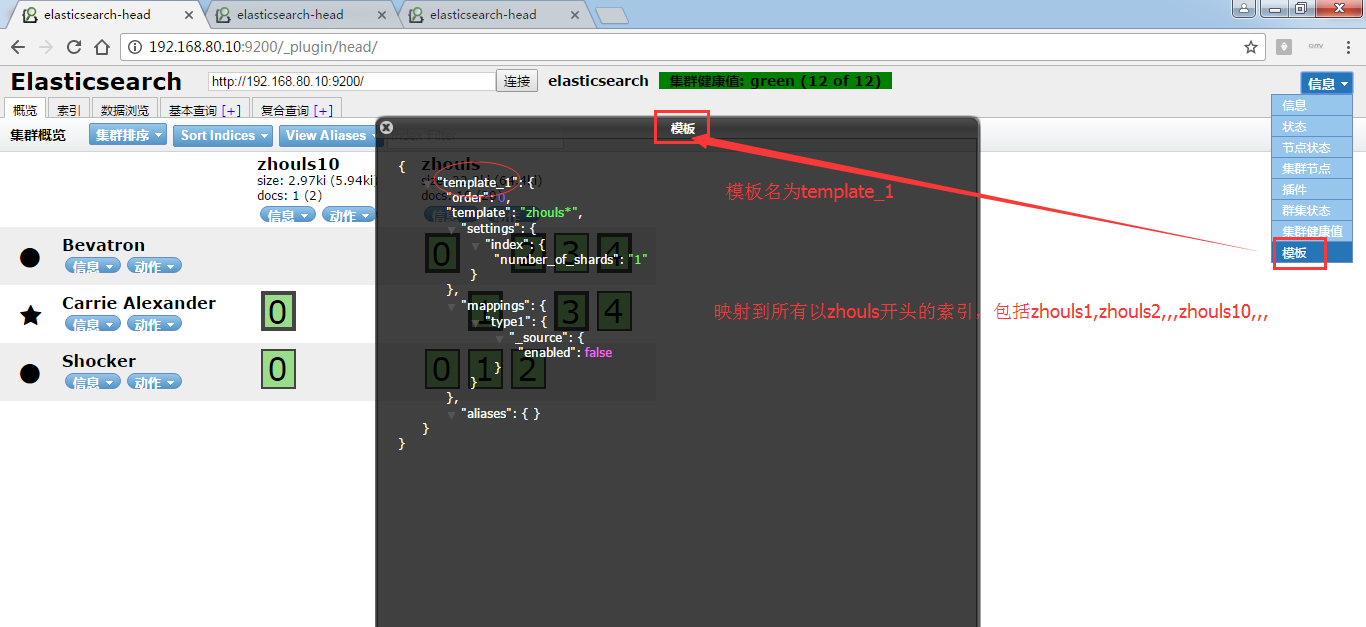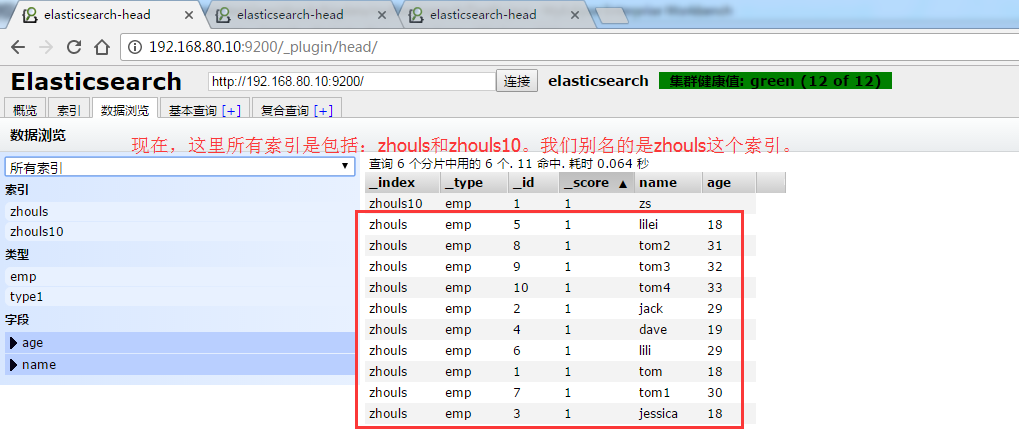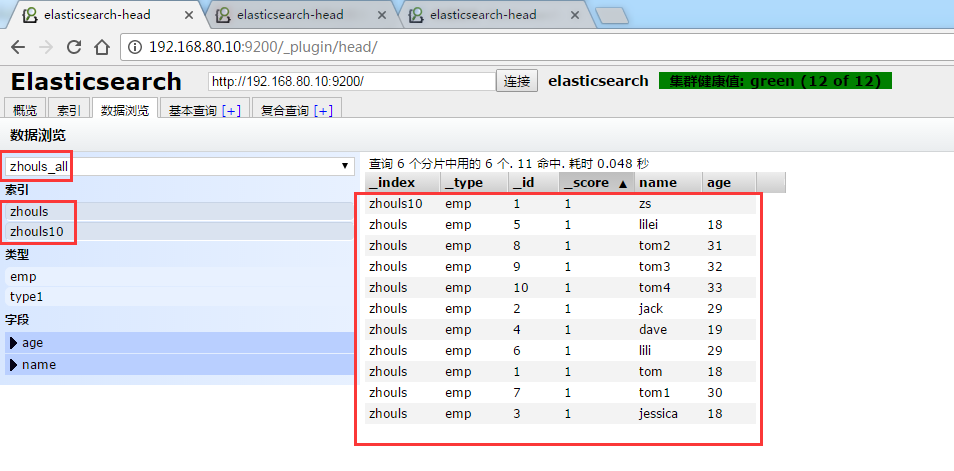Elasticsearch之索引模板index template与索引别名index alias
为什么需要索引模板?
在实际工作中针对一批大量数据存储的时候需要使用多个索引库,如果手工指定每个索引库的配置信息(settings和mappings)的话就很麻烦了。
所以,这个时候,就存在创建索引模板的必要了!!1
索引可使用预定义的模板进行创建,这个模板称作Index templates。模板设置包括settings和mappings,通过模式匹配的方式使得多个索引重用一个模板。
更多,请见
https://www.elastic.co/guide/en/elasticsearch/reference/2.4/indices-templates.html
索引别名的应用场景:
比如,公司使用es收集应用的运行日志,每个星期创建一个索引库,这样时间长了就会创建很多的索引库,操作和管理的时候很不方便。
由于新增索引数据只会操作当前这个星期的索引库,所以就创建了两个别名。
curr_week:这个别名指向这个星期的索引库,新增数据操作这个索引库。
last_3_month:这个别名指向最近三个月的所有索引库,因为我们的需求是查询最近三个月的日志信息。
后期只需要修改这两个别名和索引库之间的指向关系即可。应用层代码不需要任何改动。
还要把三个月以前的索引库close掉,留存最近一年的日志数据,一年以前的数据删除掉。
说明:可以类似,指定多个索引库查询。定义一个索引别名,如zhouls_all,将索引zhouls1映射到这个别名上,把索引zhouls2,把索引zhoulsn,也映射到这个别名上。
那么,在通过别名来查询时,直接同查询别名zhouls_all,就可以把对应所有的索引zhouls,1,2,...n都一次性查询完了。
但是,如果你是具体要插入和操作数据,则,就不方便使用别名了。而是具体到某个索引zhoulsn了。
一、索引模板index template操作示例
比如,我们会创建zhouls,zhouls1,zhouls2,,,等这样的索引库。那么,我们创建模板索引库指定是zhouls*。
那么,
1、创建自定义模板

在es的安装目录下,输入,如下,回车
curl -XPUT 192.168.80.10:9200/_template/template_1 -d ' { "template" : "zhouls*", "order" : 0, "settings" : { "number_of_shards" : 1 }, "mappings" : { "type1" : { "_source" : { "enabled" : false } } } } '
说明: (1)模板template_1匹配所有的以zhouls开头的索引。
(2)索引模板是template_1,索引是zhouls*。

[hadoop@HadoopMaster elasticsearch-2.4.3]$ curl -XPUT '192.168.80.10:9200/zhouls10/emp/1' -d '{"name":"zs"}' (给索引zhouls10赋值)
{"_index":"zhouls10","_type":"emp","_id":"1","_version":1,"_shards":{"total":2,"successful":2,"failed":0},"created":true}[hadoop@HadoopMaster elasticsearch-2.4.3]$
[hadoop@HadoopMaster elasticsearch-2.4.3]$
[hadoop@HadoopMaster elasticsearch-2.4.3]$ curl -XGET http://192.168.80.10:9200/zhouls10/_settings?pretty
{
"zhouls10" : {
"settings" : {
"index" : {
"creation_date" : "1488280491485",
"uuid" : "R4dWmru2T9uO1JFOE98r5w",
"number_of_replicas" : "1",
"number_of_shards" : "1",
"version" : {
"created" : "2040399"
}
}
}
}
}
[hadoop@HadoopMaster elasticsearch-2.4.3]$


2、查看定义的模板

curl -XGET 192.168.80.10:9200/_template/template_1

我这里,创建定义模板temp*就省略了。
3、删除定义模板

[hadoop@HadoopMaster elasticsearch-2.4.3]$ curl -XDELETE 192.168.80.10:9200/_template/template_1 (删除定义的模板)
{"acknowledged":true}[hadoop@HadoopMaster elasticsearch-2.4.3]$
[hadoop@HadoopMaster elasticsearch-2.4.3]$ curl -XGET http://192.168.80.10:9200/_template/template_1?pretty (查看,可见删除模板成功)
{ }
[hadoop@HadoopMaster elasticsearch-2.4.3]$

[hadoop@HadoopMaster elasticsearch-2.4.3]$ curl -XDELETE 192.168.80.10:9200/_template/temp* (删除定义的模板)
{"acknowledged":true}[hadoop@HadoopMaster elasticsearch-2.4.3]$
[hadoop@HadoopMaster elasticsearch-2.4.3]$ curl -XGET http://192.168.80.10:9200/_template/temp*?pretty (查看下,删除成功)
{ }
[hadoop@HadoopMaster elasticsearch-2.4.3]$

4、创建多个索引模板
当存在多个索引模板时并且某个索引两者都匹配时,settings和mpapings将合成一个配置应用在这个索引上。合并的顺序可由索引模板的order属性来控制。
curl -XPUT 192.168.80.10:9200/_template/template_1 -d ' { "template" : "*", "order" : 0, "settings" : { "number_of_shards" : 1 }, "mappings" : { "type1" : { "_source" : { "enabled" : false } } } } '
得到,


然后,输入如下:再创建一个模板
curl -XPUT 192.168.80.10:9200/_template/template_2 -d ' { "template" : "te*", "order" : 1, "settings" : { "number_of_shards" : 1 }, "mappings" : { "type1" : { "_source" : { "enabled" : true } } } } '
得到,



[hadoop@HadoopMaster elasticsearch-2.4.3]$ curl -XGET 192.168.80.10:9200/_template/template_1 (查看模板template_1)
{"template_1":{"order":0,"template":"*","settings":{"index":{"number_of_shards":"1"}},"mappings":{"type1":{"_source":{"enabled":false}}},"aliases":{}}}[hadoop@HadoopMaster elasticsearch-2.4.3]$
[hadoop@HadoopMaster elasticsearch-2.4.3]$ curl -XGET 192.168.80.10:9200/_template/template_2 (查看模板template_1)
{"template_2":{"order":1,"template":"te*","settings":{"index":{"number_of_shards":"1"}},"mappings":{"type1":{"_source":{"enabled":true}}},"aliases":{}}}[hadoop@HadoopMaster elasticsearch-2.4.3]$
[hadoop@HadoopMaster elasticsearch-2.4.3]$
上述order为1的配置将覆盖order为0的配置,最终索引的配置source的enabled为true。
注意:order值大的模板内容会覆盖order值小的。
5、模板配置文件:
除了以上方式,索引模板也可以在文件中进行配置。索引模板的配置文件需要在每个
主节点的config目录下,目录结构为:config/templates/template_1.json,temp
late_1.json的样例如下:
1 {
2 "template-logstash" : {
3 "template" : "logstash*",
4 "settings" : {
5 "index.number_of_shards" : 5,
6 "number_of_replicas" : 1,
7 "index" : {
8 "store" : {
9 "compress" : {
10 "stored" : true,
11 "tv": true
12 }
13 }
14 }
15 },
16 "mappings" : {
17 "_default_" : {
18 "properties" : {
19 "dynamic" : "true",
20 },
21 },
22 "loadbalancer" : {
23 "_source" : {
24 "compress" : true,
25 },
26 "_ttl" : {
27 "enabled" : true,
28 "default" : "10d"
29 },
30 "_all" : {
31 "enabled" : false
32 },
33 "properties" : {
34 "@fields" : {
35 "dynamic" : "true",
36 "properties" : {
37 "client" : {
38 "type" : "string",
39 "index" : "not_analyzed"
40 },
41 "domain" : {
42 "type" : "string",
43 "index" : "not_analyzed"
44 },
45 "oh" : {
46 "type" : "string",
47 "index" : "not_analyzed"
48 },
49 "responsetime" : {
50 "type" : "double",
51 },
52 "size" : {
53 "type" : "long",
54 "index" : "not_analyzed"
55 },
56 "status" : {
57 "type" : "string",
58 "index" : "not_analyzed"
59 },
60 "upstreamtime" : {
61 "type" : "double",
62 },
63 "url" : {
64 "type" : "string",
65 "index" : "not_analyzed"
66 }
67 }
68 },
69 "@source" : {
70 "type" : "string",
71 "index" : "not_analyzed"
72 },
73 "@timestamp" : {
74 "type" : "date",
75 "format" : "dateOptionalTime"
76 },
77 "@type" : {
78 "type" : "string",
79 "index" : "not_analyzed",
80 "store" : "no"
81 }
82 }
83 }
84 }
85 }
86 }
二、索引别名index alias操作示例
1、增加索引别名

curl -XPOST 'http://192.168.80.10:9200/_aliases' -d ' { "actions" : [ { "add" : { "index" : "zhouls", "alias" : "zhouls_all" } } ] }'
即,zhouls是索引,zhouls_all是索引别名


可以看到,成功啦!
2、可以同时为多个索引映射到一个索引别名

curl -XPOST 'http://192.168.80.10:9200/_aliases' -d ' { "actions" : [ { "add" : { "index" : "zhouls", "alias" : "zhouls_all" } }, { "add" : { "index" : "zhouls10", "alias" : "zhouls_all" } } ] }'

3、删除索引别名
1、删除索引zhouls映射的索引别名zhouls_all

curl -XPOST 'http://192.168.80.10:9200/_aliases' -d ' { "actions" : [ { "remove" : { "index" : "zhouls", "alias" : "zhouls_all" } } ] }'

2、删除索引zhouls10映射的索引别名zhouls_all

curl -XPOST 'http://192.168.80.10:9200/_aliases' -d ' { "actions" : [ { "remove" : { "index" : "zhouls10", "alias" : "zhouls_all" } } ] }'

作者:大数据和人工智能躺过的坑
出处:http://www.cnblogs.com/zlslch/
本文版权归作者和博客园共有,欢迎转载,但未经作者同意必须保留此段声明,且在文章页面明显位置给出原文链接,否则保留追究法律责任的权利。
如果您认为这篇文章还不错或者有所收获,您可以通过右边的“打赏”功能 打赏我一杯咖啡【物质支持】,也可以点击右下角的【好文要顶】按钮【精神支持】,因为这两种支持都是我继续写作,分享的最大动力!


